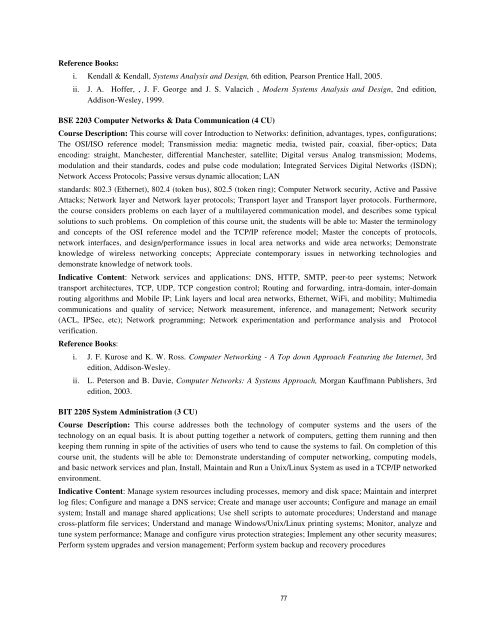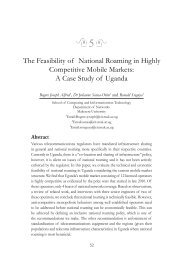Undergraduate Handbook - School of Computing and Informatics ...
Undergraduate Handbook - School of Computing and Informatics ...
Undergraduate Handbook - School of Computing and Informatics ...
You also want an ePaper? Increase the reach of your titles
YUMPU automatically turns print PDFs into web optimized ePapers that Google loves.
Reference Books:<br />
i. Kendall & Kendall, Systems Analysis <strong>and</strong> Design, 6th edition, Pearson Prentice Hall, 2005.<br />
ii. J. A. H<strong>of</strong>fer, , J. F. George <strong>and</strong> J. S. Valacich , Modern Systems Analysis <strong>and</strong> Design, 2nd edition,<br />
Addison-Wesley, 1999.<br />
BSE 2203 Computer Networks & Data Communication (4 CU)<br />
Course Description: This course will cover Introduction to Networks: definition, advantages, types, configurations;<br />
The OSI/ISO reference model; Transmission media: magnetic media, twisted pair, coaxial, fiber-optics; Data<br />
encoding: straight, Manchester, differential Manchester, satellite; Digital versus Analog transmission; Modems,<br />
modulation <strong>and</strong> their st<strong>and</strong>ards, codes <strong>and</strong> pulse code modulation; Integrated Services Digital Networks (ISDN);<br />
Network Access Protocols; Passive versus dynamic allocation; LAN<br />
st<strong>and</strong>ards: 802.3 (Ethernet), 802.4 (token bus), 802.5 (token ring); Computer Network security, Active <strong>and</strong> Passive<br />
Attacks; Network layer <strong>and</strong> Network layer protocols; Transport layer <strong>and</strong> Transport layer protocols. Furthermore,<br />
the course considers problems on each layer <strong>of</strong> a multilayered communication model, <strong>and</strong> describes some typical<br />
solutions to such problems. On completion <strong>of</strong> this course unit, the students will be able to: Master the terminology<br />
<strong>and</strong> concepts <strong>of</strong> the OSI reference model <strong>and</strong> the TCP/IP reference model; Master the concepts <strong>of</strong> protocols,<br />
network interfaces, <strong>and</strong> design/performance issues in local area networks <strong>and</strong> wide area networks; Demonstrate<br />
knowledge <strong>of</strong> wireless networking concepts; Appreciate contemporary issues in networking technologies <strong>and</strong><br />
demonstrate knowledge <strong>of</strong> network tools.<br />
Indicative Content: Network services <strong>and</strong> applications: DNS, HTTP, SMTP, peer-to peer systems; Network<br />
transport architectures, TCP, UDP, TCP congestion control; Routing <strong>and</strong> forwarding, intra-domain, inter-domain<br />
routing algorithms <strong>and</strong> Mobile IP; Link layers <strong>and</strong> local area networks, Ethernet, WiFi, <strong>and</strong> mobility; Multimedia<br />
communications <strong>and</strong> quality <strong>of</strong> service; Network measurement, inference, <strong>and</strong> management; Network security<br />
(ACL, IPSec, etc); Network programming; Network experimentation <strong>and</strong> performance analysis <strong>and</strong> Protocol<br />
verification.<br />
Reference Books:<br />
i. J. F. Kurose <strong>and</strong> K. W. Ross. Computer Networking - A Top down Approach Featuring the Internet, 3rd<br />
edition, Addison-Wesley.<br />
ii. L. Peterson <strong>and</strong> B. Davie, Computer Networks: A Systems Approach, Morgan Kauffmann Publishers, 3rd<br />
edition, 2003.<br />
BIT 2205 System Administration (3 CU)<br />
Course Description: This course addresses both the technology <strong>of</strong> computer systems <strong>and</strong> the users <strong>of</strong> the<br />
technology on an equal basis. It is about putting together a network <strong>of</strong> computers, getting them running <strong>and</strong> then<br />
keeping them running in spite <strong>of</strong> the activities <strong>of</strong> users who tend to cause the systems to fail. On completion <strong>of</strong> this<br />
course unit, the students will be able to: Demonstrate underst<strong>and</strong>ing <strong>of</strong> computer networking, computing models,<br />
<strong>and</strong> basic network services <strong>and</strong> plan, Install, Maintain <strong>and</strong> Run a Unix/Linux System as used in a TCP/IP networked<br />
environment.<br />
Indicative Content: Manage system resources including processes, memory <strong>and</strong> disk space; Maintain <strong>and</strong> interpret<br />
log files; Configure <strong>and</strong> manage a DNS service; Create <strong>and</strong> manage user accounts; Configure <strong>and</strong> manage an email<br />
system; Install <strong>and</strong> manage shared applications; Use shell scripts to automate procedures; Underst<strong>and</strong> <strong>and</strong> manage<br />
cross-platform file services; Underst<strong>and</strong> <strong>and</strong> manage Windows/Unix/Linux printing systems; Monitor, analyze <strong>and</strong><br />
tune system performance; Manage <strong>and</strong> configure virus protection strategies; Implement any other security measures;<br />
Perform system upgrades <strong>and</strong> version management; Perform system backup <strong>and</strong> recovery procedures<br />
77

















